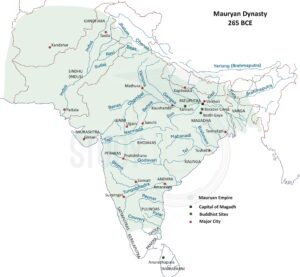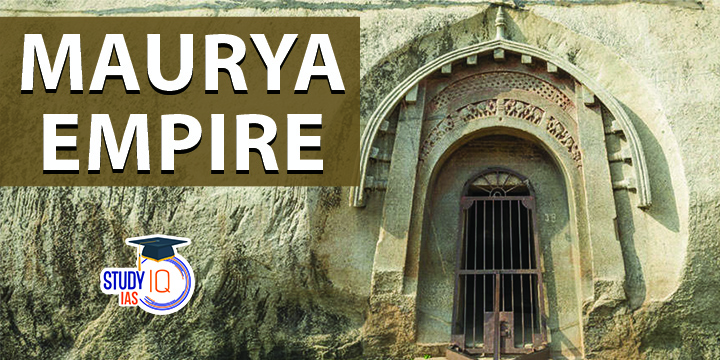Table of Contents
Mauryan Empire History
Under the leadership of Chandragupta Maurya and Chanakya, the Maurya Empire was founded in the Magadha region. The Mauryan Empire, which lasted from 321 BCE to 185 BCE, was the first pan-Indian monarchy to control the majority of the Indian subcontinent. Land consolidation was initiated by Chandragupta Maurya as Alexander the Great’s power began to wane.
After Alexander’s death in 323 BCE, Chandragupta gathered an army, overthrew the Nanda kingdom in eastern India’s Magadha region, and established the Mauryan Empire. The Nanda Empire was a substantial, aggressive, and prosperous empire. After the Nanda Dynasty was overthrown, the Maurya Empire entered the picture.
When it was at its height under Emperor Ashoka, the empire, which covered more than five million square kilometres, was recognised as the largest on the Indian subcontinent. The Himalayas, the Ganges River to the north, the Bay of Bengal to the east, the Indus River to the west, and the Arabian Sea to the west were mountains that encircled it on three sides. As Chandragupta’s chief minister, Kautilya, also known as Chanakya, made a significant contribution to the history of the empire.
Founder of Mauryan Empire
Chandragupta Maurya
Chandragupta Maurya laid the groundwork for the Mauryan Empire in the fourth century BC. He built a strong army and a sizable empire from the ground up. He deposed the Greek Satraps of the North-West Frontier and the Nandas of Magadha, uniting most of the Indian subcontinent under his one-party rule.
He was the first Mauryan emperor and was also referred to as Smarat Chakravartin, or the Universal Emperor. With the aid of Chanakya, he overthrew Dhananand, the final emperor of the Nanda Dynasty. In the year 321 BC, he vanquished Alexander’s general Selucus Nicator, negotiated a contract with him, and they got married..
In exchange for his marriage to Selucus Nicator’s daughter, Chandragupta Maurya received 500 elephants and a portion of North Western India. Megasthenese, a Greek diplomat, visited during the reign of Chandragupta Maurya. By the name of Sandrokottos, Chandragupta Maurya was known to Greek scholars. Under the influence of Bhadrabahu, Chandragupta Maurya converted to Jainism and left for Shravanabelagola, where he slowly starved to death in the Chandragiri Hills near Mangalore, Karnataka.
List of Mauryan Empire Rulers
Here is the List of Maurya Empire Rulers
| Ruler | Span of Rule |
| Chandragupta Maurya | 321- 297 BC |
| Bindusara | 297- 272 BC |
| Ashoka | 272-232 BC |
| Dasaratha | 252 – 224 BC |
| Samprati | 224- 215 BC |
| Salisuka | 215- 202 BC |
| Devavarman | 202- 195 BC |
| Satadhanvan | 195- 187 BC |
| Brihadratha | 187- 185 BC |
Kings of Mauryan Empire
Chandragupta Maurya (324/321 – 297 BCE)
Chandragupta Maurya and Chanakya/Kautilya worked together to establish the Mauryan dynasty.
A Greek author named Justin claims that Chandragupta Maurya conquered all of India with an army of 600,000. Seleucus, who ruled over the region west of the Indus, had enslaved northwestern India; he freed it. Chandragupta appears to have won the battle with the Greek viceroy. Eventually, there was peace between the two, and Seleucus granted him eastern Afghanistan, Baluchistan, and the region west of the Indus River in exchange for 500 elephants.
He was the mastermind behind the construction of the Mauryan Empire, first establishing himself in Punjab before moving east to take over the Magadhan region. Chandragupta established a massive empire that comprised the Deccan, good areas of western and northern India, Bengal, Orissa, and Bihar. The Mauryans ruled over the whole continent, with the exception of Kerala, Tamil Nadu, and some regions of northeastern India.
Bindusara (297 – 273 BCE)
Greek scholars also referred to him as Amitrochates (destroyer of foes), and the Mahabhasya calls him Amitraghata (killer of enemies). The Ajivika sect describes a fortune teller who foretold Bindusara’s son Ashoka’s glory in the future. Between the Arabian Sea and the Bay of Bengal, Bindusara conquered the region.
According to Taranatha, a Tibetan monk who published a history of Buddhism in the 17th century, one of Binduasara’s lords named Chanakya overthrew the nobles and kings of 16 towns and established himself as the ruler of the entire region between the eastern and western seas. He maintained diplomatic contacts with western kingdoms, according to the Greek source. Strabo claims that Deimachus was sent as an ambassador to Bindusara’s court by Antiochus, the Syrian monarch. Bindusara allegedly became a member of the Ajivika sect. Nearly the entire subcontinent (up to Karnataka) was ruled by the Mauryan Empire during his reign.
Ashoka (268 – 232 BCE)
After Bindusara passed away in 273 BCE, there was a four-year succession dispute. Susima, the son of Bindusara, was to be his successor. Ashoka ascended to the throne with the aid of a minister named Radhagupta and the murder of 99 brothers. During the reign of Bindusara, Ashoka served as the viceroy of Taxila and Ujjain, two cities that primarily handled trade operations.
One of history’s greatest kings, Ashoka is credited with being the first to write inscriptions that allowed him to stay in touch with his subjects. The emperor also went by the names Buddhashakya (inscribed in the Maski edict), Dharmasoka (inscribed in the Sarnath inscription), Devanampiya (meaning beloved of the gods), and Piyadassi (meaning of pleasing appearance), which were recorded in the Buddhist chronicles Dipavamsa and Mahavamsa from Sri Lanka.
His queens are described in depth in the Mahavamsa and the Dipavamsa. He was wed to Mahadevi, the mother of Mahendra and Sanghamitra, two famous Ashoka children who contributed to the spread of Buddhism, and the daughter of a Vidisha trader. Asandhimitta, Padmavati, Tissarakhita (who attempted to cut down the Bodhi tree), and Karuvaki (the only queen to be mentioned in the queen’s edict, where she is described as the mother of prince Tivara, the only son of Ashoka to be mentioned by name in inscriptions) are also mentioned in the Buddhist texts.
Mauryan Empire Art and Architecture
The largest structure from the Chandragupta Maurya era is thought to be the former palace at Pataliputra, which is today known as Kumhrar in Patna. Important information about the Mauryan Dynasty is found in Megasthenes’ work Indica. Similar descriptions of the empire are given by Fa-Hien and the monk “Hiuen Tsang.” The remnants of the palace have been discovered during excavations; it is thought that they were a collection of different buildings, the most prominent of which was a sizable pillared hall constructed on a high wood substratum. Other buildings sculpted during the Mauryan period comprised stone pillars, rock-cut tunnels, and enormous figure carvings in addition to stupas and viharas.
Many different types of stonework were constructed during the Ashokan era, including lion sightings, stupa railings, enormous free-standing pillars, and other enormous monuments. At this time, stone was used to such an advanced level of perfection that artists polished even little pieces of stone art to a high shiny sheen resembling magnificent enamel. On the foundation Ashoka laid, Sanchi Stupa was constructed. The stupa’s interior structure was made of unburned brick, while the thickness of its outer walls was made of roasted brick. Examples: The most well-known Ashokan stupa is Sanchi Stupa, located in MP. Ashoka constructed a number of stupas, which are sizable domes covered in Buddha images. Other notable structures include those at Ashoka’s pillars at Nandangarh and the Sanchi Stupa, as well as those at Nagarjunakonda, Sanchi, Bharhut, Amaravati, Bodhgaya, and Bharhut.
Mauryan Empire Administration
Central Government
- The Mauryan government was very centralised.
- The Emperor served as the ultimate authority and the fount of all power.
- He received help from a Council of Ministers. It was known as the “Mantriparishad.” The clergy were referred to as “Mantris.”
- A “mantriparishad-adhyakshya,” or modern-day prime minister, presided over the council.
- Tirthas: The administration’s highest level of officials. 18 Tirthas were present.
- Adhyakshya: Only Tirthas is ranked higher. Twenty Adhyakshyas were present. They served both military and economic purposes.
- Mahamattas: Senior government employees.
- Amatyas: High-ranking representatives who resemble today’s secretaries. They performed judicial and administrative functions.
- A secretariat comprised of various departments was created from the Adhyakshyas.
- The Arthashastra lists numerous Adhyakshyas for various things, including trade, warehouses, gold, ships, agriculture, cows, horses, cities, chariots, the mint, and troops..
- Officers in charge of land measurement and boundary marking are known as Rajjukas. Mint superintendents are known as Sansthadhyasksha.
- Samasthadhyasksha: Market Superintendent
- Sulkaadhyaksha: the toll superintendent
- Sitaadhyaksha: Agriculture Superintendent
- Navadhyaksha: Ship’s Superintendent
- Lohadhyaksha: Iron Works Superintendent
- Pauthavadhyakhsa: the weights and measures superintendent
- Akaradhyaksha: Mines superintendent
- Vyavharika Mahamatta: Members of the judiciary
- Public relations specialists in Pulisanj
- The administration had control over the registration of births, deaths, immigrants, industries, trade, the manufacture and sale of commodities, and the collecting of sales taxes.
Local Administration
- The village served as the smallest administrative entity.
- Village leader: Gramika Villages enjoyed a high degree of autonomy.
- District magistrates or provincial governors were known as Pradeshika.
- Tax collectors who work for Pradeshikas are known as Sthanika.
- Durgapala: Fort Governors
- Antapala: Frontier governors.
- Accountant General Akshapatala and Scribes Lipikaras
Military
- Senapati served as the Emperor’s right-hand man and served as the head of the entire military. The Emperor appointed him.
- The military was split into the infantry, cavalry, chariots, elephant forces, navy, and transport and supplies sectors.
- The army received its salary in cash.
Revenue
- Samharta, the head of the tax department, and Sannidhata, another significant official (treasurer).
- Land, irrigation, businesses, customs, woods, ferries, mining, and pastures all generated revenue. Artisans were required to pay licence fees, and fines were assessed in court.
- One-sixth of the produce’s earnings came from the land..
Police
- There were police stations in each of the major cities.
- Bandhangara was the name of the jail, while Charaka was the name of the cellblock.
Espionage
- The Mauryas had an advanced system of intelligence gathering.
- The markets and bureaucracy were reported to the Emperor by spies.
- Spies could be classified as either Sansthana (stationary) or Sanchari (wanderer).
- The Mahamatyapasarpa controlled the detectives or secret agents known as Gudhapurushas. These agents were chosen from a variety of social groups.
- Additionally, there were agents known as Vishakanyas (poisonous girls).
Transport
- The width of the chariots, livestock paths, and pedestrians were set by the transportation agency.
Mauryan Empire Map

Mauryan Empire Cultural Significance
At the outset of the empire, Hinduism was the sole religion practised. Hinduism, Jainism, and Buddhism are three distinct religions that emerged in India under the secular government of the Mauryans. Ashoka retained Hindu Brahmana priests and ministers in his court even after converting to Buddhism. The Mauryans were against the caste system and prejudice.
Mauryan Empire Rivals and Wars
| Pataliputra (319 BC) | The Brahmin Chanakya, mentor of Chandragupta, boldly confronts the Nanda dynasty with a group of mercenaries. |
| Maghada (317 BC) | Chandragupta fights the Nandas once more, this time under the command of the powerful general Bhadrasala. |
| Mayalaketu (317 BC) | The rebel general Mayalaketu and his troops are attacked by Chanakya in their camp. |
| Takshashila (316 BC) | In support of the Indian king Ambhi, the Thracian general Eudamus defends Takshashila from Chandragupta’s attack. |
| Gandhara (304 BC) | Seleucus I Nicator, a former officer of Alexander the Great and current “Master of Babylonia,” crosses the Indus river to attack Gandhara but is met by the Mauryan army on the banks of the river. |
| Revolt in the Provinces (275 BC) | In order to remove a rebel siege of Takshashila and free the elderly Chanakya who is holed up in the city’s palace, Chandragupta’s grandson Ashoka sends a relief force. |
| Khashas (274 BC) | Bhindusara, the son of Chandragupta, attacks the mountain strongholds of the independent Khasha rulers and overthrows their alliance. |
| Kalinga (261 BC) | Ashoka’s army invade the kingdom of Kalinga in the largest and most bloodiest set-piece battle of the Mauryan era. |
Mauryann Empire Decline
In 232 BCE, Ashoka’s leadership came to an end, initiating the fall of the Mauryan empire. A multitude of things led to the vast empire’s downfall and disintegration, including:
Buddhist Reaction
Ashoka was against the slaughter of animals and pets even if they had a policy of religious tolerance. Due to Ashoka’s anti-sacrifice stance, the Brahmanical society, which depended on the offerings made in the name of sacrifices, suffered. The Brahmanas consequently developed some sort of hostility toward Ashoka.
Economic crisis
The Mauryan Empire maintained the largest army, which necessitated high economic burdensome costs for paying the soldiers and officials.
Negative rule
Under Bindusara’s administration, Ashoka gave the mahamatras the order to abstain from torturing the public without cause. He implemented officer rotation in Ujjain, Taxila, and Tosali to address this issue. However, persecution persisted in the outlying areas.
Dissemination of new knowledge
The Shungas, Kanvas, and Chetis were founded on the tangible knowledge that was gathered from the Magadha, and they later expanded.
North-West Frontier Ignorance
Ashoka participated in both internal and foreign missionary activities. Beginning with successive invasions, the Greeks first made it to India and then attacked northern Afghanistan. The Mauryan Empire finally came to an end thanks to Pushyamitra Shunga, the leader of the Shunga tribe. At Pataliputra, he overthrew the last dynastic heir to seize the throne (Brihadratha). The Shungas continue to follow the customs and laws of the Brahmanical way of life. The Shungas were mentioned by the Kanvas.


 AI Maker Labs: A Promise to build AI in ...
AI Maker Labs: A Promise to build AI in ...
 Daily Quiz 15 April 2025
Daily Quiz 15 April 2025
 How RBI Responded To Global Trade War Ch...
How RBI Responded To Global Trade War Ch...





















